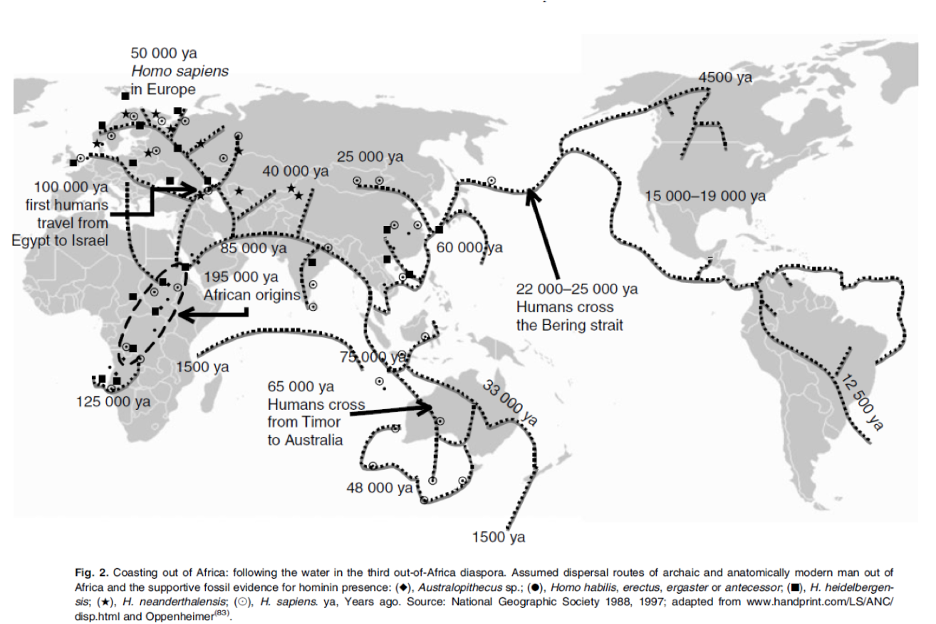Andrea Nunez-Garcia and Lora Iannotti
Humans need water to survive. This was true for our hominin ancestors over millions of years, leading us to hunt, gather, and fish near water sources. During certain periods in our evolution, archeological evidence shows that members of the Hominini lineage began consuming foods from the shoreline, such as mollusks, crustaceans, shallow freshwater fish (e.g., catfish), sea-bird eggs, turtles, and more. This diet was rich in nutrients such as zinc, iodine, and omega-three fatty acids and likely contributed to our larger brain size compared to other primates.
Why does the fish story from our evolutionary past matter today? It is important because some populations around the world have lost access to the shore-based diets or similar nutrient rich animal foods with serious consequences for their health and survival. Let’s go back in time to explore how fish and other animal source foods (ASFs) became integral to the anatomy and physiology of our species, enduring nearly two million years until agriculture and industrialization again revolutionized diets with health consequences.

Our Hominini Family
The term hominin refers to extinct members of our evolutionary past belonging to the Hominini taxon. Within the Hominini lineage, only Homo sapiens remain today on our planet.
Extinct members include Australopithecus, Homo habilis, Homo erectus, and Homo neanderthalensis, among others. Through time, distinct characteristics and behaviors emerged that were associated with adaptation and survival for members of the Homo genus: erect posture and bipedal mobility (4.2-3.9 million years ago); creation and utilization of tools (2.4 to 1.5 million years ago); increases in brain size (2 to 1.7 million years ago), and ability to control fire (1 million years ago to 500 thousand years ago).

Anatomical differences between hominins have been studied extensively by scientists and many features of our anatomy and physiology have been attributed to diet changes, particularly the consumption of ASFs, including fish. This dietary shift was documented in the H. erectus or H. ergaster group specifically but likely occurred approximately two million years ago over many years and across different hominins. Anatomical differences in this hominin species included a taller stature, larger body mass, smaller teeth, and larger brain size— three times the encephalization quotient (brain mass: body mass) compared to their ancestors (Kuipers et al. 2012).
Habitat and Adaptation
There is consensus that our species’ first home was Africa where we survived and evolved for millions of years. Archeological evidence shows our ancestors lived around freshwater lakes, marshes, rivers, and estuaries in regions of East and South Africa. Shell middens, made of hard minerals enduring over time, suggest use of these mollusks for building materials and tools, but also in diets.

Evidence shows Australopithecus occupied shore habitats in Eastern and Southern Africa as early as 4 to 3 million years ago. Fossils, shells, and fish remains have also been found at a number of “human” sites in East and Southern Africa, such as the Nile Corridor, Rift Valley Lakes, and South African Cape sites (Broadhurst et al., 2000).
Although there is evidence that our hominin ancestors foraged for fish and other shore-based foods close to water some 4 million years ago, more sophisticated “fishing” activities did not occur until later in our evolution. The creation and use of tools by hominin species does not seem to appear until 2 million years ago. Increased cranial capacity and humanlike hand bones and structures in this period may have led to the discovery and creation of tools by such hominins as Homo habilis, Homo erecutus, and Homo neanderthalensis. Early tools made from pebbles were used for chopping or scrapping. As evolution progressed, tools became increasingly more advanced and required more precision. Advanced tools included spears and blades created and sharpened using flaking techniques. Such tools may have been beneficial in preparing and consuming marine foods.
Hominins would eventually migrate from Africa, often moving along coasts and other water ways.

Our ancestors trekked to many different habitats and biomes diversifying greatly their food sources. This has been a defining characteristic of hominins in evolution, our ability to adapt to and survive on a wide array of foods. Evidence shows that gatherer-hunter-fisher diets were diverse across many different food groups. Only about 10,000 years ago, however, did we start to settle and cultivate plant foods, losing some access to ASFs and, without doubt, dietary diversity. More monotonous diets resulted in nutrient deficiencies and increased risks for stunted growth, infectious diseases, and mortality. With industrialization, a mere two centuries ago in our history, humans began consuming processed foods. Ultra-processed foods, in particular, have been associated with problems of overweight, obesity, and chronic diseases.
In 1985, two scientists introduced the discordance theory, positing that the human genome evolved to adapt to conditions that no longer exist and that the mismatch lead to increases in chronic diseases (Eaton & Konner, 1985). This theory was expanded to populations across the entire nutrition spectrum, not only those with overnutrition problems but also vulnerable groups to undernutrition, who have been impacted by these dramatic dietary changes (Eaton & Iannotti, 2014). The losses in dietary quality and proportional shifts in macronutrient intakes are incongruent with how our genomes evolved, increasing our risks for health and developmental deficits. Today, people living in poverty who are unable to afford higher quality and diverse diets are especially vulnerable to both short- and long-term health and development consequences. Nutrient deficiencies in iron, zinc, vitamin A, or essential fatty acids found in fish foods compromise brain development, diminish physical stature, and raise susceptibilities to infection and chronic disease.
Shoring Up Brains: Gatherer-Hunter-Fisher Foods
Research from gatherer-hunter-fisher diets suggests that nutrition during the Paleolithic period was considerably more diverse, but there were other differences in macro- and micronutrient intakes as well (Cordain et al., 2000). Our hominin ancestors consumed higher proportions of protein and fats than we do today relative to carbohydrates. The kinds of fats were also different—derived from shored-based foods and lean meats—with increased concentrations of omega-3 fatty acids and long-chain fatty acids more specifically (e.g., DHA) necessary for brain development. Evidence shows other commonly foraged foods were berries and other fruits, herbs and leafy vegetables, nuts, seeds, tubers, and honey. In sum, the diets of our hominin ancestors were diverse and nutrient-rich.
Between 2 to 1.7 million years ago, our hominin ancestors developed larger brains and cranial capacity, which may in part be due to the shifts in diets containing “brain-selective” nutrients (Cunnane & Crawford, 2014). More dramatic increases in brain size as measured by the encephalization quotient in later hominins following Australopithecus coincided with the introduction of ASFs in the diet. This increase in brain size may have similarly been driven by other environmental and behavioral changes, but there is a biological basis to the connection with diet, particularly fish and other ASFs. These foods contain higher concentrations of omega-3 fatty acids and other nutrients such as choline, iron, zinc, and vitamins A and B12 that can increase brain volume, but more importantly development and function (Goyal et al., 2018). As we shifted to a plant-based diet some 10,000 years ago with the introduction of agriculture, we lost access to fish and other ASFs, as well dietary diversity, with health consequences. What many don’t recognize, however, is that we also lost a small proportion of brain size!
Conclusion
The Hominini branch of ancestors extends over millions of years, and through this evolution, anatomical and physiological differences across hominins have been linked to diets. ASFs, especially those foraged from shore-based environments, came onto the scene approximately two million years ago, enabling increases in stature and brain size. The gatherer-hunter-fisher groups migrated along waterways and maintained these nutrient-rich and diverse diets, until we gradually settled and began cultivating plants. In only a tiny fraction of our evolutionary past (<1%), humans around the world have consumed diets that are very different from our ancestors with health and developmental consequences.
While it is unrealistic for the world’s population of 7.8 billion to return to a gatherer-hunter-fisher existence, we can work towards ensuring better access to fish foods and higher quality diets for the nutritionally vulnerable globally. The Feed the Future Fish Innovation Lab for Fish is working to increase fish availability for human nutrition globally with research initiatives specifically in the countries of Nigeria, Kenya, Zambia, Bangladesh, and Cambodia. These projects are working on novel approaches in aquaculture (e.g., farm diversification, biosecurity and feedstock for catfish, value-chain improvements), fisheries (e.g., coral reef sustainability, gear modification), and social and behavioral change strategies (e.g., demand creation through social marketing, dried fish powder in complementary foods) to better ensure access to fish foods and, ultimately, nutrition security.
Let’s shore up brains and healthy bodies for all.
References
Aiello, L. C., and Wells, J. C. (2002). Energetics and the evolution of the genus Homo. Annual Review of Anthropology, 31, 323–338.
Broadhurst, C. L., Cunnane, S. C., and Crawford, M. A. (1998). Rift Valley lake fish and shellfish provided brain-specific nutrition for early Homo. British Journal of Nutrition, 79(1), 3-21.
Cordain, L., Miller, J. B., and Eaton, S. B. (2000). Plant-animal subsistence ratios and macronutrient energy estimations in worldwide hunter-gatherer diets. The American Journal of Clinical Nutrition, 7, 682–692.
Cunnane, S. C., and Crawford, M. A. (2014). Energetic and nutritional constraints on infant brain development: Implications for brain expansion during human evolution. Journal of Human Evolution, 77, 88-98.
Eaton, J. C., and Iannotti, L. L. (2017). Genome-nutrition divergence: evolving understanding of the malnutrition spectrum. Nutrition Reviews, 75(11), 934-950.
Eaton, S.B., and Konner, M. (1985). Paleolithic nutrition. New England Journal of Medicine, 312, 283–289.
Editors of Encyclopædia Britannica. (2020). Hominin. In Encyclopædia Britannica. Retrieved October 29, 2020, from https://www.britannica.com/topic/hominin
Goyal, M.S., Iannotti, L. L., and Raichle, M. E. (2018). Brain nutrition: A life span approach. Annual Review of Nutrition, 38, 381-399.
Kuipers, R. S., Joordens, J. C., and Muskiet, F.A. (2012). A multidisciplinary reconstruction of Palaeolithic nutrition that holds promise for the prevention and treatment of diseases of civilisation. Nutrition Research Reviews, 25(1), 96-129. doi:10.1017/S0954422412000017
About the Authors
Andrea Nunez-Garcia is a Master of Public Health student at Washington University in St. Louis and a graduate student researcher at the university’s E3 Nutrition Lab. Lora Iannotti is the nutrition specialist for the Fish Innovation Lab, as well as a PI on the lab’s SecureFish and Samaki Salama projects. She is an associate professor at Washington University in St. Louis and director of the E3 Nutrition Lab.
Published November 6, 2020
